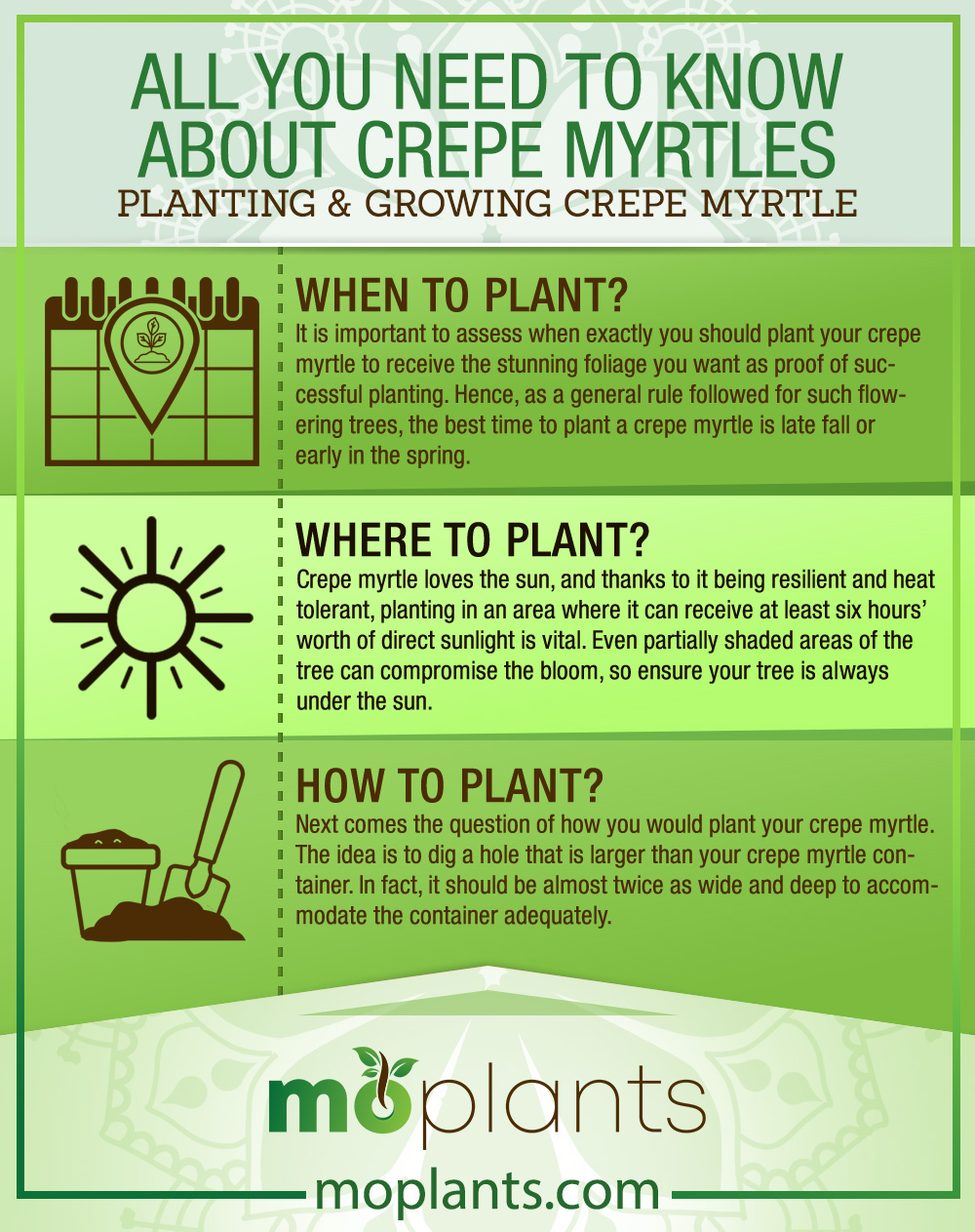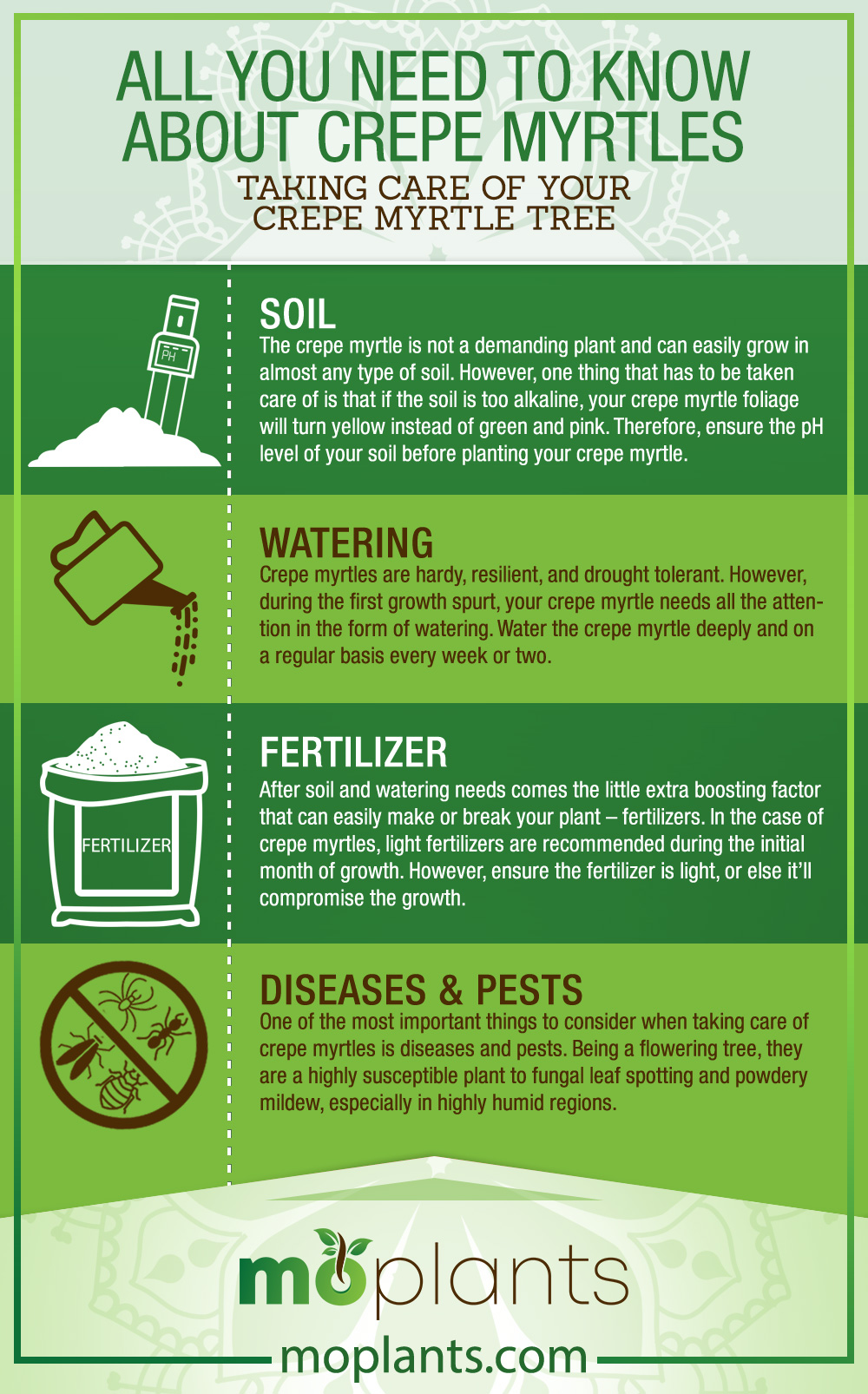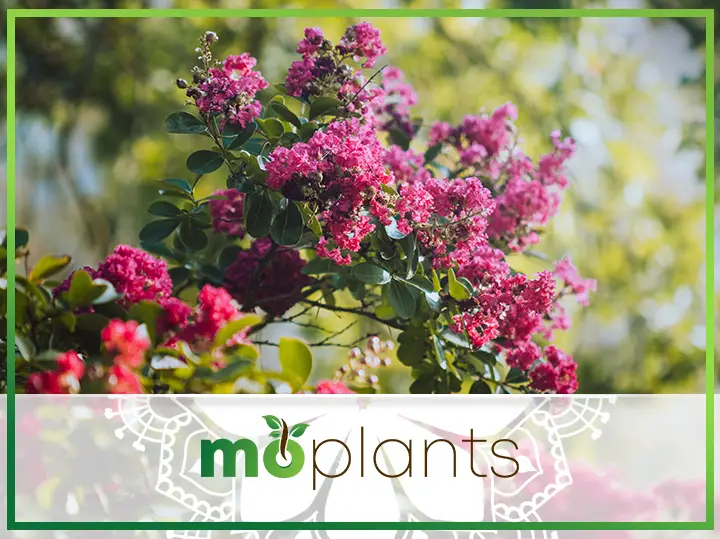Beautiful pink flowery trees are hard to miss. However, these certain types of flowering shrubs are all quite similar unless you inspect them closely. So one can’t be sure from afar what exactly the plant you are looking at is.
But one thing is for sure that such flowering trees and plants look really beautiful and would make a gorgeous addition to your garden. So if you have been on the lookout for such flowering trees and shrubs to grow in your home garden, you have come to the right place.
We are going to break down all growth and care information about a beautiful flowing plant from the Southern side of the world called crepe myrtle. If you have been a fan of blooming trees and shrubs, you will surely find this choice appealing and include it in your garden.
So let’s get started, shall we?
Crepe Myrtle – Background
Crepe myrtle, botanically known as Lagerstroemia, is a descendent of over 50 species of similar deciduous shrubs and trees. These evergreen plants are actually native to the Indian subcontinent and can be traced back to their Southeast Asian homes.
In fact, the genus name “lagerstroemia” is derived from the name of the Swedish merchant who was the director of the East India Company and used to supply his precious plant collectibles to the infamous Swedish botanist Carl Linnaeus.
That is basically how this flowering plant found its way gradually but surely towards the western part of the world and has been an essential part of home-grown flowering trees ever since. People find it easy to grow and take care of the plant.
All About Crepe Myrtle
Crepe myrtle essentially is a flowering tree. It has a stark similarity to bougainvillea. However, a very basic difference between the two is simply that while a bougainvillea is a flowering shrub, a crepe myrtle is a flowering tree.
It produces brightly colored flowers in pink and can be seen planted around in neighborhoods as well as for commercial use as ornaments. Moreover, because it is a tree, it has also been developed as a hybrid to produce smaller sizes that can easily and safely be kept indoors.
Hence, you can find the crepe myrtle size range starting from a dwarf tree of merely two feet going up to tall, towering trees with all of them equally beautiful, if not more. They all have that year-long, showy flowers with signature attractive foliage.
One of the best things about crepe myrtle is that it ticks all the boxes of being your very own flowering tree in your garden. From having the availability and ease of choosing the perfect size to having the attraction of nice foliage and showy, bright flowers to look beautiful even in autumn and winter – it truly is a personal garden-friendly tree.
In fact, unlike other flowering plants that are exceptionally hard to grow and even harder to maintain and take care of, the crepe myrtle is quite hardy once you have successfully led its planting and growth spurt and established its roots like a tree.
The crepe myrtle got its name because of the crepe-like texture that its pink flowers have. Although the flowers do not produce a particular scent, their beauty lies in how they look with their crepe-textured petals and grow as showy pink foliage covering the whole tree.
Furthermore, many people also like the fact that if you leave the crepe myrtle tree on its own as it starts growing and blooming flowers, it actually grows into a very neat formation with its branches, leaves, and flowers. A single tree trunk branches out into vase-shaped flower bunches.
However, a feature of the crepe myrtle becomes more apparent as it ages, and that is its bark. The older the tree gets, the bark becomes even more beautiful with its wrap-around, mottled trunk in shades of silver, grey, brown, and pink.
Hence, one of the best ways to know if the crepe myrtle tree that you are looking at is an old one in the neighborhood. You can surely inspect its trunk and know for sure if it’s a recently grown blooming tree or something being taken care of for generations.
Additionally, it is important to note here that crepe myrtle showcases summer flowers called terminal panicles. So essentially, while the flower itself is very small, these panicles are quite big, almost 15 cm in width to 30 cm in length.
This is what causes a beautifully widened foliage of the crepe myrtle tree. At the end of each branch, these flowers and panicles form vase-like open bunches, including the beautifully textured crepe petals looking ruffled and distinctive.
Finally, the crepe myrtle is deciduous. So you can expect it to change the colors of its bright pink flowers to reds, browns, and yellows as the branches shed out in the fall season. Soon enough, the tree is completely bare in the season, but that certainly doesn’t take away from its beauty.
The tree’s architectural symmetry, trunk, and branches make it look like a gorgeous and interesting showpiece in your garden. And before you know it, your bright pink flowering tree is again back with its all-encompassing foliage.
Planting & Growing Crepe Myrtle
Now that you are well-versed about this amazing flowering tree, i.e., crepe myrtle, it is time to learn how to plant and grow your own crepe myrtle tree for a bright pink flowery inclusion in your garden.
However, no need to be intimidated, given that it’s a flowering tree with promising foliage, and growing it might be a hassle. Compared to other flowering trees, the crepe myrtle is a quite hardy choice that isn’t too demanding even in the planting and growth stage.
So take out garden gloves and a hat to get planting!
When to Plant?
First things first, it is important to assess when exactly you should plant your crepe myrtle to receive the stunning foliage you want as proof of successful planting. Hence, as a general rule followed for such flowering trees, the best time to plant a crepe myrtle is late fall or early in the spring.
This allows the plant enough time to establish its roots before the dormant winter period and extremely hot summer weather. Although crepe myrtles can be very resilient and can be planted even in summers, planting them at a good time just makes your job easier.
Where to Plant?
Next is the assessment of where to plant your crepe myrtle. Now, the space you have in mind to plant your crepe myrtle can be up to you for aesthetic purposes. However, the space for growth purposes must be chosen according to the preferences of the plant.
Crepe myrtle loves the sun, and thanks to it being resilient and heat tolerant, planting in an area where it can receive at least six hours’ worth of direct sunlight is vital. Even partially shaded areas of the tree can compromise the bloom, so ensure your tree is always under the sun.
How to Plant?
Next comes the question of how you would plant your crepe myrtle. The idea is to dig a hole that is larger than your crepe myrtle container. In fact, it should be almost twice as wide and deep to accommodate the container adequately.
Next, you should see if the tree placement is centered in the hole, after which you can start backfilling in steps and continue watering every step of the way. The root ball should be placed slightly above the ground level to take in oxygen and water after planting.
Infographic

Tips for Pruning Crepe Myrtle
For now, you have planted your crepe myrtle and have figured out when, where, and how to do so. Now it is time to ensure your future crepe myrtles are successful, and that needs to be done by pruning. Although there are many different schools of thought when it comes to pruning crepe myrtles, here are some tips that can help you complete them:
- Don’t chop down a full crepe myrtle into ugly stubs just for pruning purposes.
- Try to remove any branches that are crossing the center and clean up the dead wood.
- Try trimming the premature flowers in the blooming season to promote a second blooming.
- Do not go for annually reducing the height of your tree to pruning a short one.
- Do not thin out your foliage just for pruning. Instead, cut out branches in the fall season.
Taking Care of Your Crepe Myrtle Tree
The responsibility of successfully planting and growing a crepe myrtle doesn’t end unless you have established certain care factors for all-year-round growth and maintenance of the tree. Hence, there are certain elements that you have to provide so that you don’t compromise on all the hard work you have put in from the planting and growth.
Soil
The crepe myrtle is not a demanding plant and can easily grow in almost any type of soil. However, one thing that has to be taken care of is that if the soil is too alkaline, your crepe myrtle foliage will turn yellow instead of green and pink.
Therefore, ensure the pH level of your soil before planting your crepe myrtle. Moreover, even with any type of soil, crepe myrtle needs thorough draining, so keep your drainage system in check.
Watering
Crepe myrtles are hardy, resilient, and drought tolerant. However, during the first growth spurt, your crepe myrtle needs all the attention in the form of watering. Water the crepe myrtle deeply and on a regular basis every week or two.
In fact, you are recommended to increase the watering during extremely hot summer weather. The idea is that the crepe myrtle will absorb the water nutrients it needs while draining out the excess water it doesn’t need.
Fertilizer
Next, after soil and watering needs comes the little extra boosting factor that can easily make or break your plant – fertilizers. In the case of crepe myrtles, light fertilizers are recommended during the initial month of growth. However, ensure the fertilizer is light, or else it’ll compromise the growth.
If we consider the crepe myrtle already an established tree, fertilizer accompanied with a slow and gradual release of its content is recommended before the next bloom in spring. This shall allow a successful next blooming season, especially if you’re worried about it happening.
Moreover, a light feeding also goes a long way in keeping your crepe myrtle healthy as it is a heavy feeder tree. However, even with the feeder application, watering is highly important. You can also use mulch to protect the roots during extremely hot and cold weather.
Diseases & Pests
Lastly, one of the most important things to consider when taking care of crepe myrtles is diseases and pests. Being a flowering tree, they are a highly susceptible plant to fungal leaf spotting and powdery mildew, especially in highly humid regions.
Moreover, aphids and scale are also not rare sightings for crepe myrtles. Hence, these problems are better solved by working with a garden specialist who can have a variety of options as solutions according to your crepe myrtle.
Infographic

Wrap Up
It is safe to say that crepe myrtle is one of the most beautiful and comparatively the least challenging flowering trees to grow in your garden. It is definitely a flowering tree worth having in your garden.
Given how it ceases to compromise its beauty all year round despite shedding its flowers in the fall season makes it all the better. Hopefully, you find our all-encompassing guide about crepe myrtles helpful in including a tree of your own.
Are you feeling like you would be interested in reading more about growth and care or educational plant guides? Then connect with us at Mo Plants – your one-stop gardening directory for more gardening know-how.
Our comprehensive guides will be an excellent resource for reading more about other plants, vegetables, herbs, and fruits to expand your home garden into a colorful sanctuary of a diverse range of amazing plants from all over the world.
Happy planting!


